Water-Wise Gardening Tips
share

 |
Turn off your manual irrigation timer during the winter months From about November through April our local weather patterns are too erratic for clock-based irrigation controllers. There may be weeks at a time when absolutely no irrigation is needed. Turn your controller to “off” during these cool months. If the garden needs water you can turn the system to “manual” for a complete irrigation. Even better, install a new Smart timer, that is weather sensitive. |
||
 |
Re-direct your rain gutter downspouts Rather than direct your gutter downspouts to the sidewalk, driveway or storm drain, direct then into your landscape. Not only will the water be appreciated by your plants, but a portion of the water may help to replenish our natural underground aquifer. Roof water that goes into a storm drain and to the ocean is wasted and a very unnatural situation. |
||
 |
Install rain barrels or other water storage tanks Roof water downspouts are perfectly designed to collect water - and then immediately remove it from the landscape and deposit it into a storm drain. Too bad. But downspouts are also perfect for filling rain barrels or water storage tanks. Consider that just a half inch of rain falling on a 1,000-square-foot roof yields 300 gallons of free water. Most roofs are 2,000-3,000 square feet. Over the course of an entire season that’s a lot of water. |
||
 |
Hydrozone your plants Group plants according to their water needs, then organize your irrigation zones and irrigation schedule to match these plant groupings. This is called “hydrozoning” and is one of the most important principles of good landscape water conservation. Adding water conserving plants to your garden is terrific, but if mixed with thirstier plants in the same irrigation zone, their water conserving habits are lost. |
||
 |
Switch your outdated irrigation controller to a “Smart” controller Most irrigation controllers are clock-based timers, irrigating based on dates and times, indifferent to weather or plant needs. Imagine operating your air conditioning and heating based on dates and times only - with no thermostat. Not very effective. Smart irrigation timers monitor air temperature, rainfall, humidity and wind. They also consider the types of plants in each irrigation zone, the slope, exposure and type of sprinklers. Healthier plants and way less water. |
||
 |
Fix leaky garden faucets It would seem obvious, but many gardens have a faucet or two that leak. This constant dripping can add up to a lot more water than you might think - up to 20 gallons a day or 600 gallons a month for each leak. Often, all that is needed is a 25 cent washer. |
||
 |
Add mulch over exposed soil A layer of mulch can cut down water evaporation by as much as 75 percent and studies suggest it can reduce overall water use by 25 percent or more. Mulch can be any loose material placed over the soil to conserve water, control weeds and keep soil temperature more constant. It is usually a coarse organic product, like shredded cedar or shredded redwood. |
||
 |
Use a broom instead of a hose to clean driveways and sidewalks This simple habit saves 150 gallons or more each time, or up to 10 gallons per minute. Be sure you also instruct your gardener or landscape maintenance company to put down the hose and pick up a broom. |
||
 |
Set your lawn mower blades one notch higher Longer grass will reduce evaporation and water use. Cool-season grasses, like fescues (Marathon), bluegrass and ryegrass can often be mowed at least a half-inch higher. This higher height will shade and cool the soil below the leaves and also encourage deeper rooting. Try it, it works. Unfortunately, this higher mowing height is not recommended for warm-season grasses, like hybrid bermuda. |
||
 |
Avoid exposed sloped soils Exposed soil, especially when the area has even a modest slope, is a real water waster. The water runs off, which also adds to loss of topsoil and coastal pollutants. Covering the soil, either with a thick mulch or with groundcover or other shrubbery. Shredded mulches are especially good for this, since they bind together and do not wash down the slope. |
||
 |
Meet with your gardener or landscape maintenance company Your gardener works for you. Make a point to meet with them and tell them what you want. Start with no overspray on the sidewalks/gutters, frequent adjustments to your irrigation controller and mulch maintained over all exposed soil. While you’re at it, tell them you only want to use organic products in your garden. If they balk and can’t accommodate - get a new service. |
||
 |
Remove or reduce your turf size Turf is the thirstiest part of your landscape; usually by a big margin. Turf also consumes much of a landscape’s maintenance effort and expense. Lawns produce most of the water runoff and are the source of much of our coastal and bay pollutants. Because of the power equipment used in the maintenance lawns also contribute to the burning off fossil fuels and green waste issues. If you don’t “use” your lawn, why have it? When it comes to lawns, consider the motto “either use, reduce or loose.” |
||
 |
Apply water slowly, rather than quickly Soils soak up water slowly. (Approximately .2 to .4 inches per hour for clay soils and .75 inches per hour for sandy loam). Standard “pop-up” heads put down 1.5 inches per hour - or more. The water is applied faster than it can be absorbed, meaning much of the water ends up running in the gutter. MP Rotator heads apply water at less than .5 inches per hour, meaning better absorption and less waste. |
||
 |
Find out how much water your sprinklers are applying Applying ½ inch of water to clay soil will moisten it to a root depth of about 6 inches. You can determine how long it takes to apply ½ inch of water by setting out several cans, running your sprinklers, and measuring the time it takes to fill them to ½ inch. It’s really quite simple, just be sure to use can with straight sides, not tapered. They can be any diameter - used food cans work perfect. Put several out and you may be surprised how inconsistently your sprinkler are delivering water. |
||
 |
Lose the lawn A 1,000 sq. ft. lawn (about normal) that is watered for 10 minutes once a day with traditional sprinklers will use about 8400 gallons per month. If the lawn is replaced with a traditional groundcover and watered 4 hours per week, the water use is about 2,100 gallons per month. If the lawn is replaced with native groundcover and watered with water efficient rotator-sprinklers for 20 minutes per week the water use is about 200 gallons per month. |
 |
|
Turn off your manual irrigation timer during the winter months From about November through April our local weather patterns are too erratic for clock-based irrigation controllers. There may be weeks at a time when absolutely no irrigation is needed. Turn your controller to “off” during these cool months. If the garden needs water you can turn the system to “manual” for a complete irrigation. Even better, install a new Smart timer, that is weather sensitive. |
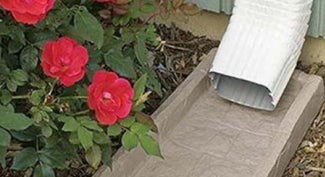 |
|
Re-direct your rain gutter downspouts Rather than direct your gutter downspouts to the sidewalk, driveway or storm drain, direct then into your landscape. Not only will the water be appreciated by your plants, but a portion of the water may help to replenish our natural underground aquifer. Roof water that goes into a storm drain and to the ocean is wasted and a very unnatural situation. |
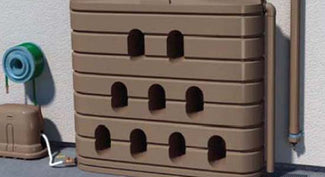 |
|
Install rain barrels or other water storage tanks Roof water downspouts are perfectly designed to collect water - and then immediately remove it from the landscape and deposit it into a storm drain. Too bad. But downspouts are also perfect for filling rain barrels or water storage tanks. Consider that just a half inch of rain falling on a 1,000-square-foot roof yields 300 gallons of free water. Most roofs are 2,000-3,000 square feet. Over the course of an entire season that’s a lot of water. |
 |
|
Hydrozone your plants Group plants according to their water needs, then organize your irrigation zones and irrigation schedule to match these plant groupings. This is called “hydrozoning” and is one of the most important principles of good landscape water conservation. Adding water conserving plants to your garden is terrific, but if mixed with thirstier plants in the same irrigation zone, their water conserving habits are lost. |
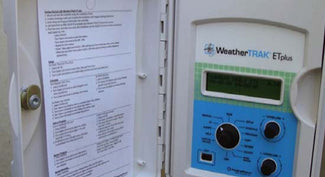 |
|
Switch your outdated irrigation controller to a “Smart” controller Most irrigation controllers are clock-based timers, irrigating based on dates and times, indifferent to weather or plant needs. Imagine operating your air conditioning and heating based on dates and times only - with no thermostat. Not very effective. Smart irrigation timers monitor air temperature, rainfall, humidity and wind. They also consider the types of plants in each irrigation zone, the slope, exposure and type of sprinklers. Healthier plants and way less water. |
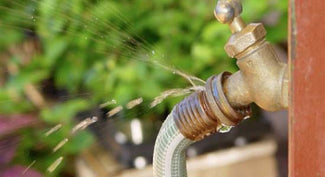 |
|
Fix leaky garden faucets It would seem obvious, but many gardens have a faucet or two that leak. This constant dripping can add up to a lot more water than you might think - up to 20 gallons a day or 600 gallons a month for each leak. Often, all that is needed is a 25 cent washer. |
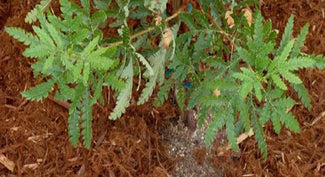 |
|
Add mulch over exposed soil A layer of mulch can cut down water evaporation by as much as 75 percent and studies suggest it can reduce overall water use by 25 percent or more. Mulch can be any loose material placed over the soil to conserve water, control weeds and keep soil temperature more constant. It is usually a coarse organic product, like shredded cedar or shredded redwood. |
 |
|
Use a broom instead of a hose to clean driveways and sidewalks This simple habit saves 150 gallons or more each time, or up to 10 gallons per minute. Be sure you also instruct your gardener or landscape maintenance company to put down the hose and pick up a broom. |
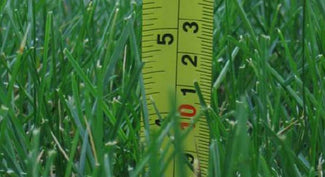 |
|
Set your lawn mower blades one notch higher Longer grass will reduce evaporation and water use. Cool-season grasses, like fescues (Marathon), bluegrass and ryegrass can often be mowed at least a half-inch higher. This higher height will shade and cool the soil below the leaves and also encourage deeper rooting. Try it, it works. Unfortunately, this higher mowing height is not recommended for warm-season grasses, like hybrid bermuda. |
 |
|
Avoid exposed sloped soils Exposed soil, especially when the area has even a modest slope, is a real water waster. The water runs off, which also adds to loss of topsoil and coastal pollutants. Covering the soil, either with a thick mulch or with groundcover or other shrubbery. Shredded mulches are especially good for this, since they bind together and do not wash down the slope. |
 |
|
Meet with your gardener or landscape maintenance company Your gardener works for you. Make a point to meet with them and tell them what you want. Start with no overspray on the sidewalks/gutters, frequent adjustments to your irrigation controller and mulch maintained over all exposed soil. While you’re at it, tell them you only want to use organic products in your garden. If they balk and can’t accommodate - get a new service. |
 |
|
Remove or reduce your turf size Turf is the thirstiest part of your landscape; usually by a big margin. Turf also consumes much of a landscape’s maintenance effort and expense. Lawns produce most of the water runoff and are the source of much of our coastal and bay pollutants. Because of the power equipment used in the maintenance lawns also contribute to the burning off fossil fuels and green waste issues. If you don’t “use” your lawn, why have it? When it comes to lawns, consider the motto “either use, reduce or loose.” |
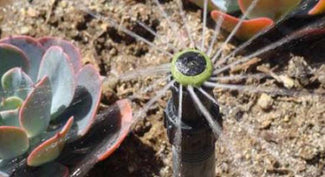 |
|
Apply water slowly, rather than quickly Soils soak up water slowly. (Approximately .2 to .4 inches per hour for clay soils and .75 inches per hour for sandy loam). Standard “pop-up” heads put down 1.5 inches per hour - or more. The water is applied faster than it can be absorbed, meaning much of the water ends up running in the gutter. MP Rotator heads apply water at less than .5 inches per hour, meaning better absorption and less waste. |
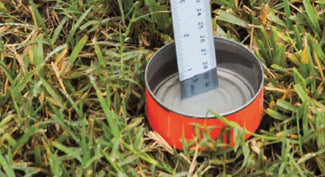 |
|
Find out how much water your sprinklers are applying Applying ½ inch of water to clay soil will moisten it to a root depth of about 6 inches. You can determine how long it takes to apply ½ inch of water by setting out several cans, running your sprinklers, and measuring the time it takes to fill them to ½ inch. It’s really quite simple, just be sure to use can with straight sides, not tapered. They can be any diameter - used food cans work perfect. Put several out and you may be surprised how inconsistently your sprinkler are delivering water. |
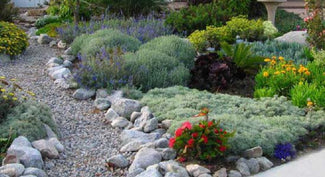 |
|
Lose the lawn A 1,000 sq. ft. lawn (about normal) that is watered for 10 minutes once a day with traditional sprinklers will use about 8400 gallons per month. If the lawn is replaced with a traditional groundcover and watered 4 hours per week, the water use is about 2,100 gallons per month. If the lawn is replaced with native groundcover and watered with water efficient rotator-sprinklers for 20 minutes per week the water use is about 200 gallons per month. |




